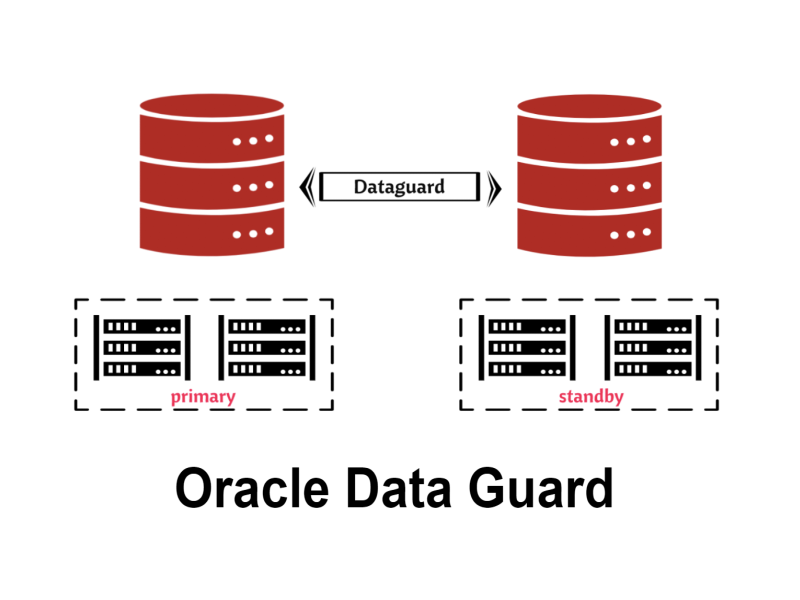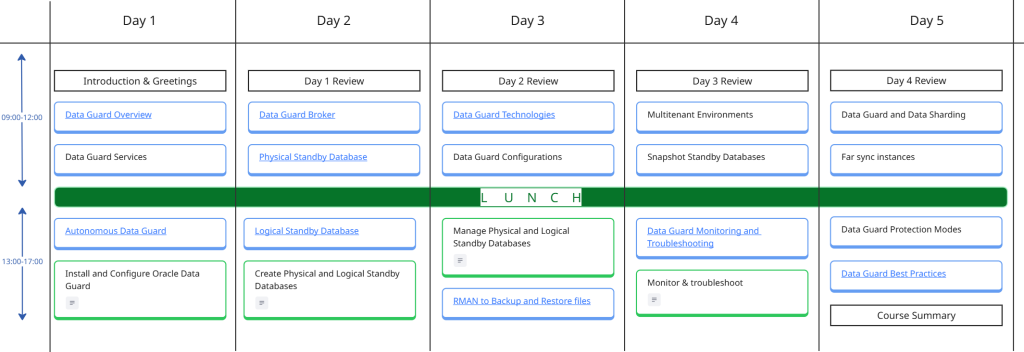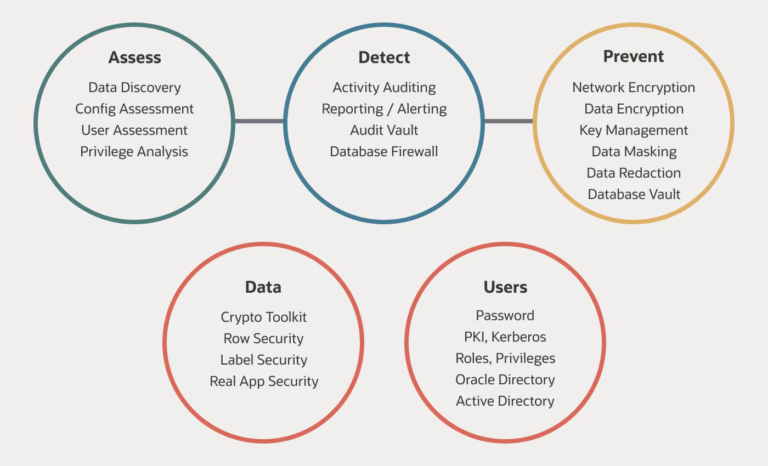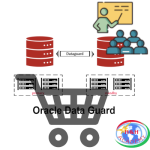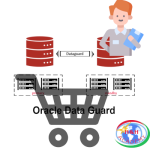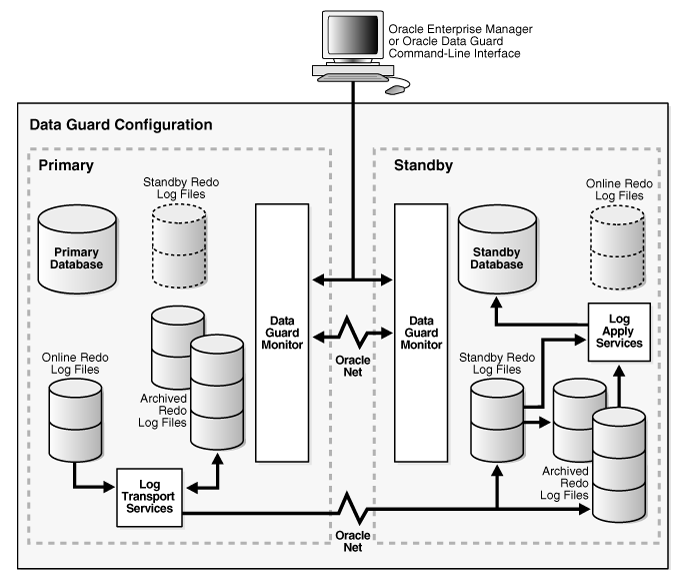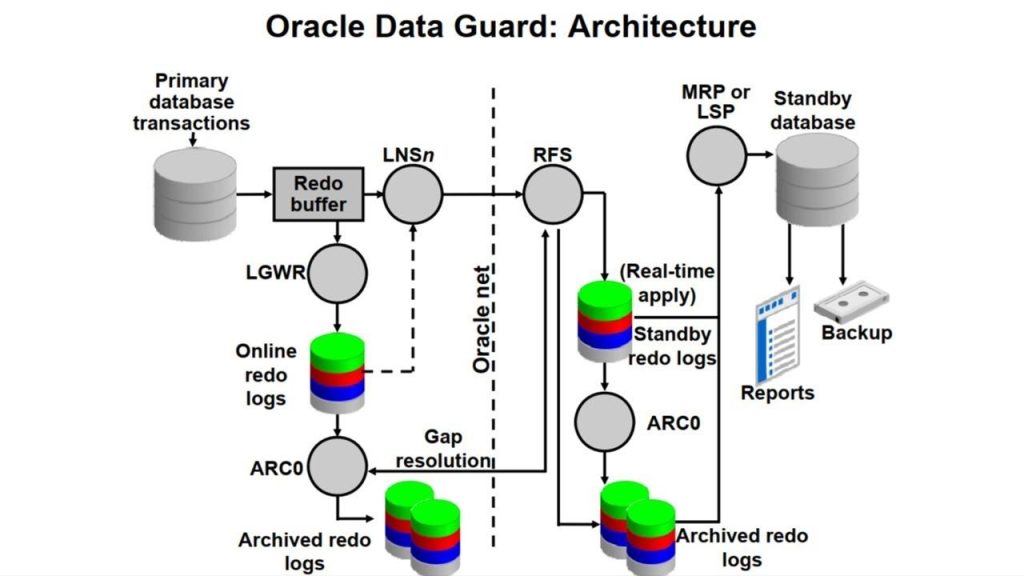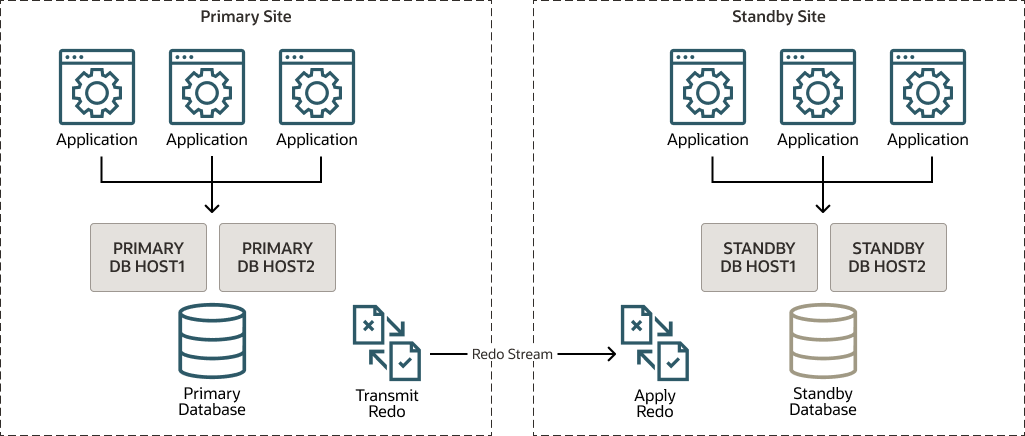Oracle Data Guard
 Oracle Data Guard
Oracle Data GuardA prime principle for every business,
Data is the first class citizen in your entire organization. Practical Hands on Labs.
Practical Hands on Labs.Many labs with hands on experience; practicing real challenging exercises
independently and supervised by your professional trainer Build confidence in your system .
Build confidence in your system .Data protection and reliability is your key,
Learn the skills and knowledge on how to improve your database protection
in accordance to Oracle Data Guard disaster recovery best practices. Live Demos! .
Live Demos! .With visual view of how the concepts can be realized using live data
and live practices by the instructor.
Thanks to the training Kata where the instructor leads and students
follow instructions step by step Earn your recognition .
Earn your recognition .Your achievements count, you earn it,
a certificate of attendance is your reward
Overivew
This course will describe the components of Oracles’ Data Guard tool covers Oracle Databases 19c and 23i. We will cover the differences between the physical and logical databases and the overall architecture of Data Guard.
Prerequisites
Knowledge
Students to this class are expected to have:
- Good understanding Cloud Computing Basics
- Basic understanding of Oracle DBA
- Basic knowledge of
- Networking and Security
- Site Operations such as RPO/RTO
- Basic understanding of computer operations skills :such as managing files
Technology
Depending on the delivery method of this course, the students should have :
- A Workstation with Internet browser capability such as (Chrome, Edge, or Safari)
- Good persistent internet connection without blocking firewalls(ideally non corporate firewall protected workstations)
The Labs
Labs are provided throughout the course
Labs covered in this course:
- Lab 1: Install and Configure Oracle Data Guard
- Lab 2: Create Physical and Logical Standby Databases
- Lab 3: Manage Physical and Logical Standby Databases
- Lab 4: Monitor and Troublshooting
Objectives
By the end of the course, students should be able to
-
Understand Database Backups and as a security measure
-
Describe Metrics to measure Data Guard reliability
-
Understand how Data Guard can support SRE Site Reliability Engineering
-
Install and configure Oracle Data Guard framework
-
Operate and sustain Oracle Database 23i Security Solutions
-
Implement metrics, alerts, and generate operational reports for Oracle Database Security Solutions
Audience
This course is designed to assist and equip the students with the skills and knowledge that allows them to perfect their daily tasks with respect to operationalize the Oracle Data Guard with confidence and capitalize the organization investment on business operation reliability.
- SRE – Site Reliability Engineers: Help develop adequate Service Level Objectives (SLO), Service Level Indicators(SLI), and Observability across the overall system with respect to Oracle Data Guard metrics
- Product Owners/Business Architect: Help define the requirements and design the acceptable SLA and KPI to the advantage of the business vs competitors
- Solution Architect: to better understand how to leverage Cloud and on-premise IT capabilities.
- Network Engineers: Understand the networking limitations and requirements and the business impact of network architecture on business
- Security Engineers: Help understand the full potentials and the risks associated with setting the controls and rules to secure Oracle Databases
- Support Staff: Help gauge and better troubleshoot and recover quickly
- Migration Engineers: Help understand the impact on system migration within security rules and controls
- Systems Architects: Develop scalable , reliable, highly available, and secure Oracle Databases.
Timeline
The Oracle Data Guard Course is a 5 days course, includes lectures, demos, and workshops.
The following is guidelines for the instructor to organize the time pace with the students, subject to change based on students preference.
Breaks during the day follows the 106 rule, every 45-60m
*the 106 rule, indicates the human memory capacity to learn the new factual elements which is 106 facts before the memory could be reused.
- Oracle Data Guard Configurations
- Oracle Data Guard Services
- Oracle Data Guard Broker
- Oracle Data Guard Protection Modes
- Client Failover
- Oracle Data Guard and Complementary Technologies
- Oracle Active Data Guard and Data Sharding
Module 2: Data Guard Services
- Redo Transport Services
- Apply Services
- Role Transitions
Module 3: Autonomous Data Guard
- What is Autonomous Database
- About Standby Databases
- Autonomous Data Guard
- Autonomous Data Guard Switchover and Failover Operations
- Autonomous Data Guard Cross-Region and Cross Tenancy Operations
- Autonomous Database Cross-Region Paired Regions
Module 4: Oracle Data Guard Broker
- Overview of Oracle Data Guard and the Broker
- Benefits of Oracle Data Guard Broker
- Oracle Data Guard Broker Components
- Oracle Data Guard Broker User Interfaces
- Oracle Data Guard Monitor
Module 5: Physical Standby Database
- What is Physical Standby Database
- Benefits of Physical Standby Database
- Create a physical Standby Database
Module 6: Logical Standby Database
- What is Logical Standby Database
- Benefits of Logical Standby Database
- Create a Logical Standby Database
Module 7: Data Guard Technologies
- Oracle Real Application Cluster (RAC)
- Oracle Real Application Cluster One Node
- Flashback Database
- Recovery Manager (RMAN)
- Oracle Global Data Services (GDS)
Module 8: RMAN to backup and restore
- About RMAN File Management in an Oracle Data Guard Configuration
- About RMAN Configuration in an Oracle Data Guard Environment
- Recommended RMAN and Oracle Database Configurations
- Backup Procedures
- Registering and Unregistering Databases in an Oracle Data Guard Environment
- Reporting in an Oracle Data Guard Environment
- Performing Backup Maintenance in an Oracle Data Guard Environment
- Recovery Scenarios in an Oracle Data Guard Environment
- Additional Backup Situations
- Restoring and Recovering Files Over the Network
- RMAN Support for CDBs In an Oracle Data Guard Environment
Module 9: Mutlitenant Environments
- Oracle Multitenant Databases
- Data Guard for Pluggable Databases
Module 10: Snapshot Standby Database
- What is snapshot Standby database
- Use cases of Snapshot Standby Database
- Create a Snapshot Standby Database
Module 11: Monitoring and Troubleshooting
- Overview about Monitoring and Troubleshooting
- Active Data Guard vs Remote Monitoring
- Monitro Primary Databases
- Monitor Standby Databases
- Alarms
- Database availability
- SRE Metrics and indicators
- Troubleshooting Oracle Data Guard
Module 12: Data Guard and Data sharding
- Verifying an Archived Location Definition
- Starting an Archive Job
- Restoring Archived Datafiles
Module 13: Far Sync Instances
- Creating a Far Sync Instance
- Alternate Destinations
- Configuring Alternate Destinations
- Supported Protection Modes for Far Sync Instances
Module 14: Data Guard Protection Modes
- Maximum Performance
- Maximum Availability
- Maximum Protection
- Setup Protection Mode
Module 15: Data Guard Best Practices
- Overview of MAA Best Practices for Oracle Data Guard
- Plan an Oracle Data Guard Deployment
- Configure and Deploy Oracle Data Guard
- Tune and Troubleshoot Oracle Data Guard
- Monitor an Oracle Data Guard Configuration
- Optimizing Automatic Failover in Common Scenarios to Minimize Downtime
Calendar
Scroll through the months, and chose the right schedule for you, send us a standard request form register



